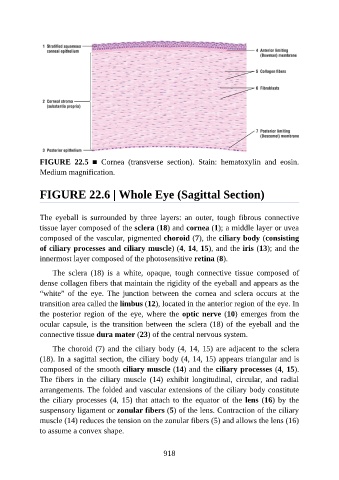Page 919 - Atlas of Histology with Functional Correlations
P. 919
FIGURE 22.5 ■ Cornea (transverse section). Stain: hematoxylin and eosin.
Medium magnification.
FIGURE 22.6 | Whole Eye (Sagittal Section)
The eyeball is surrounded by three layers: an outer, tough fibrous connective
tissue layer composed of the sclera (18) and cornea (1); a middle layer or uvea
composed of the vascular, pigmented choroid (7), the ciliary body (consisting
of ciliary processes and ciliary muscle) (4, 14, 15), and the iris (13); and the
innermost layer composed of the photosensitive retina (8).
The sclera (18) is a white, opaque, tough connective tissue composed of
dense collagen fibers that maintain the rigidity of the eyeball and appears as the
“white” of the eye. The junction between the cornea and sclera occurs at the
transition area called the limbus (12), located in the anterior region of the eye. In
the posterior region of the eye, where the optic nerve (10) emerges from the
ocular capsule, is the transition between the sclera (18) of the eyeball and the
connective tissue dura mater (23) of the central nervous system.
The choroid (7) and the ciliary body (4, 14, 15) are adjacent to the sclera
(18). In a sagittal section, the ciliary body (4, 14, 15) appears triangular and is
composed of the smooth ciliary muscle (14) and the ciliary processes (4, 15).
The fibers in the ciliary muscle (14) exhibit longitudinal, circular, and radial
arrangements. The folded and vascular extensions of the ciliary body constitute
the ciliary processes (4, 15) that attach to the equator of the lens (16) by the
suspensory ligament or zonular fibers (5) of the lens. Contraction of the ciliary
muscle (14) reduces the tension on the zonular fibers (5) and allows the lens (16)
to assume a convex shape.
918

